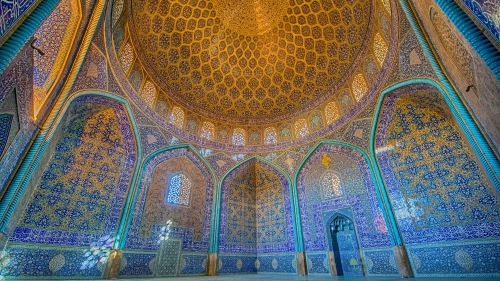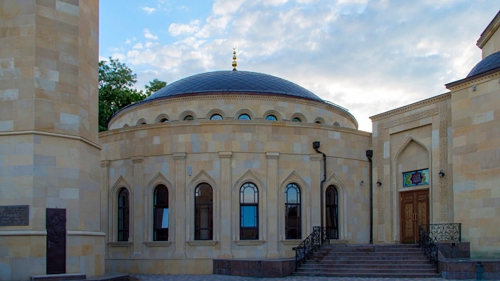A Priceless Collection of Islamic Art in Hawaii

What kind of home would you build if you were one of the wealthiest people in the country and money was no object? And you loved Islamic art? And you had fallen in love with the Hawaiian Islands? And it was the late 1930s and you were in your mid-20s?
For Doris Duke, an American heiress whose vast wealth at the time included a Fifth Avenue mansion in New York City, an estate in Newport, Rhode Island, and a 2,700 acre farm in New Jersey, the answer was Shangri La. Built between 1937 and 1938, the 14,000 square foot main house, a "playhouse" modeled on a Persian palace, and a pool and cascading water feature blend into nearly five acres of oceanfront land in the shadow of Honolulu's Diamond Head.

Indeed, Duke collected more than 3,500 valuable artifacts, art works, and furniture for Shangri La over 56 years. The estate's buildings and grounds are inspired by palaces and gardens Duke saw in Iran, India and the Middle East during a nearly year-long honeymoon she took in 1935. The artifacts and art works are from Iran, Morocco, Turkey, Syria, Span, Egypt and India.
No one is sure how Duke's estate, built on land in an area known as Ka'alawai, came to be known as Shangri La. The property is on the outskirts of Waikiki, in an area known as Black Point, the most exclusive neighborhood in Hawaii. In her introduction to the authoritative history Doris Duke's Shangri La, Carol Bier writes that the heiress may have been inspired by the 1937 hit movie "Lost Horizon," a morality tale about a secretive place in a Himalayan valley known as Shangri La, a refuge of peace and beauty in a world at war. The film was based on James Hilton's 1933 novel Lost Horizon.

The tours are managed by the Honolulu Academy of Arts, under an arrangement with the Doris Duke Foundation for Islamic Art. The foundation was established by Duke to make her Honolulu home accessible to the public and scholars interested in her unique collection of Islamic art. Visitors gather at the Honolulu Academy of Arts, where a special exhibit, "Arts of the Islamic World," and a video about Shangri La precede the 15-minute drive to the estate. Docents lead tours through many of the main house's rooms, as well as the gardens. Tours average around 1.5 hours.
Arriving at Shangri La, one is struck by what you don't see. There are none of the ostentatious signs of wealth that overwhelm you at, say, a San Simeon or Millionaires' Mile in Newport. Once you pass through a locked gate, the driveway winds its way down a gentle slope to a parking area that circles a giant banyan tree. To the right is a simple wall and door. Face ahead, toward the sea, and there's a plain faade with a single door guarded by two stone camels.

Like a hidden entry garden in a Middle Eastern home, what a visitor might find once he crosses the threshold from a street, Shangri La's courtyard is both a surprise and a delight. Light filters through tree branches - the opening in the roof is a tall two stories above the courtyard -- and the elegant simplicity of the space speaks volumes about Doris Duke's aesthetic.
Shangri La is not the home of a collector of fine art. Rather, it showcases an eclectic collection of Islamic art and artifacts, as much a reflection of Doris Duke's taste and interests as it is of the cultures represented by the pieces. How else to explain the proximity of a stunning space, called the "Turkish Room," an elaborate room purchased from a wealthy family in Syria and shipped to Honolulu, and a Persian mihrab, an intricately detailed tiled niche that's used to indicate the direction of Mecca for the faithful. In Shangri La, the mihrab faces east, not northwest as it should. But these major elements of Shangri La are indicative of Duke's broad interest in Islamic art, not to mention her ability to acquire such treasures.

Just around the corner from the living room is the dining room, which was originally done in a Hawaiian theme with saltwater aquariums that ran the length of one wall. The room opens to a lanai, which overlooks the Pacific Ocean. But Duke decided to remake the room in the 1960s. It was transformed with fabrics draped along the ceiling and walls, suggesting a large desert tent, with low table and ottomans beneath an elaborate chandelier.

Ever since the home was opened to the public in 2002, the hope has been to make the private quarters a part of the tour. There had been plans to make Duke's bedroom and bath, which was designed and manufactured in India inspired by the Taj Mahal, open to the public this year. Unfortunately, those plans have been pushed back. People who have been in the bedroom say it is just as it was when Duke died.

The public tour also allows a visitor to stroll Shangri La's gardens, the most impressive of which is the Mughal Garden. Like most doorways in the main home, the door to the garden frames a vista of a waterway that seems to stretch to the horizon. When one stands in the garden and looks toward the entrance, the doorway frames the trunk of the giant banyan tree that shades the lower driveway.
Doris Duke was so wealthy she didn't have to worry about what others thought of her plans or acquisitions. Fortunately for us, her exquisite taste has left a stunning cultural resource that's of interest to scholars as well as anyone interested in her vision of paradise. Perhaps that's one of the reasons why Duke was so comfortable in Hawaii from the moment she arrived as a newly wed in 1935 (her husband would be gone by 1940, but she kept the Hawaii home); the islands are a colorful mix of many influences, some related, others with no ties, yet their combination makes for a unique cultural identity.

As for the home, guesthouse and gardens, Shangri La reflects the super wealthy of another era. There's none of the glitter and bling that surround so many of today's ultra wealthy, and certainly Shangri La is distinguished by its taste and aesthetics compared to the line of McMansions that line tony Kahala Avenue, just a few minutes away. One is struck by the fact that while Duke had an Otis Elevator lift installed to raise and lower an entire wall, she relied on tradewinds, not air conditioning, to cool Shangri La. She clearly felt the home should be a part of its environment, and Shangri La follows the slope of the property that overlooks the Pacific, much like the Tibetan-style structures built on the sides of mountains in the movie Shangri La.
The municipal permit that allows the Doris Duke Foundation for Islamic Art to show Shangri La to visitors limits the number of people who can visit the estate to 96 per day. Tours are conducted Wednesday through Saturday. It is well worth the effort and cost to be among the fortunate few who can spend time in Doris Duke's Shangri La. It isn't often that one gets to visit another person's vision of paradise come to life. This is an opportunity that should not be missed.
Story and Photos By Floyd K. Takeuchi
HOW TO VISIT SHANGRI LA
- Call the Honolulu Academy of Arts for ticket and tour information. On Oahu, call 523-DUKE (523-3853). All others call toll-free 1-866-DUKE-TIX (385-3849).
- Shangri La is accessible to people in wheelchairs.
- The tour is not appropriate for children under the age of 12.
- For more information, or to view parts of Shangri La (such as Doris Duke's bedroom) that are not a part of the public tour, visit shangrilahawaii.org.
Source: Hawaii Red
Related Suggestions
we are a group of slamic artists and we would like to open a very unique art exhition about rumi and his poems about love, tolerance and peace.

















